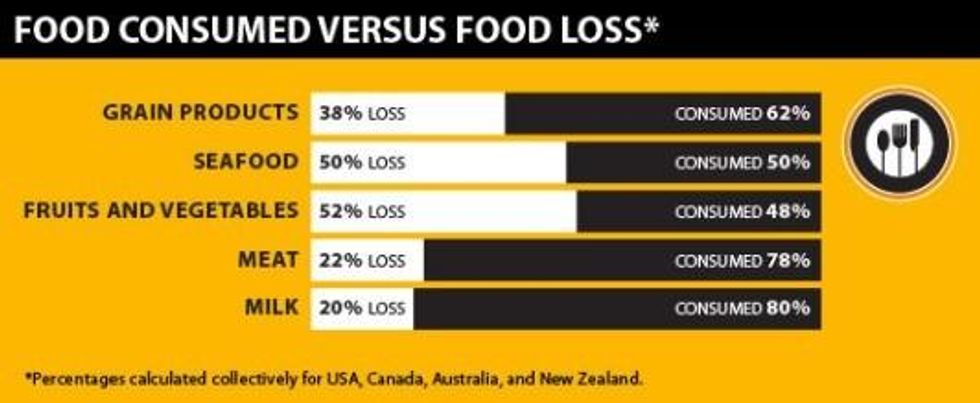America Trashes Forty Percent of Food Supply: Report
Americans throw away nearly one half of all food, causing massive environmental and fiscal damage, according to a new report by the Natural Resources Defense Council.
According to the report 40 percent of food is wasted in the US amounting to a loss of $165 billion per year. That wasted food also represents one quarter of all freshwater consumed in the US, as it is needed for agriculture and food production. Food waste is also the cause of 23 percent of methane emissions, a potent greenhouse gas.
"As a country, we're essentially tossing every other piece of food that crosses our path - that's money and precious resources down the drain," said Dana Gunders, NRDC project scientist with the food and agriculture program. "With the price of food continuing to grow, and drought jeopardizing farmers nationwide, now is the time to embrace all the tremendous untapped opportunities to get more out of our food system. We can do better."
The report, Wasted: How America is Losing Up to 40 Percent of Its Food from Farm To Fork to Landfill, pools data from case studies and government data. Its key findings also include:
- The average American family of four ends up throwing away an equivalent of up to $2,275 annually in food;
- Food waste is the single largest component of solid waste in U.S. landfills;
- Just a 15 percent reduction in losses in the U.S. food supply would save enough food to feed 25 million Americans annually;
- There has been a 50 percent jump in U.S. food waste since the 1970s.
Nationally, fresh produce is the most wasted type of food, due to inefficient and wasteful retail and restaurant practices.
However, the report also finds that everyday consumers waste large amounts of food through excessive portioning and uneaten leftovers.
"No matter how sustainably our food is farmed, if it's not being eaten, it is not a good use of resources," said Gunders. "Fortunately, there are ways to tackle the food waste problem, and everyone can play a role."

An Urgent Message From Our Co-Founder
Dear Common Dreams reader, The U.S. is on a fast track to authoritarianism like nothing I've ever seen. Meanwhile, corporate news outlets are utterly capitulating to Trump, twisting their coverage to avoid drawing his ire while lining up to stuff cash in his pockets. That's why I believe that Common Dreams is doing the best and most consequential reporting that we've ever done. Our small but mighty team is a progressive reporting powerhouse, covering the news every day that the corporate media never will. Our mission has always been simple: To inform. To inspire. And to ignite change for the common good. Now here's the key piece that I want all our readers to understand: None of this would be possible without your financial support. That's not just some fundraising cliche. It's the absolute and literal truth. We don't accept corporate advertising and never will. We don't have a paywall because we don't think people should be blocked from critical news based on their ability to pay. Everything we do is funded by the donations of readers like you. Will you donate now to help power the nonprofit, independent reporting of Common Dreams? Thank you for being a vital member of our community. Together, we can keep independent journalism alive when it’s needed most. - Craig Brown, Co-founder |
Americans throw away nearly one half of all food, causing massive environmental and fiscal damage, according to a new report by the Natural Resources Defense Council.
According to the report 40 percent of food is wasted in the US amounting to a loss of $165 billion per year. That wasted food also represents one quarter of all freshwater consumed in the US, as it is needed for agriculture and food production. Food waste is also the cause of 23 percent of methane emissions, a potent greenhouse gas.
"As a country, we're essentially tossing every other piece of food that crosses our path - that's money and precious resources down the drain," said Dana Gunders, NRDC project scientist with the food and agriculture program. "With the price of food continuing to grow, and drought jeopardizing farmers nationwide, now is the time to embrace all the tremendous untapped opportunities to get more out of our food system. We can do better."
The report, Wasted: How America is Losing Up to 40 Percent of Its Food from Farm To Fork to Landfill, pools data from case studies and government data. Its key findings also include:
- The average American family of four ends up throwing away an equivalent of up to $2,275 annually in food;
- Food waste is the single largest component of solid waste in U.S. landfills;
- Just a 15 percent reduction in losses in the U.S. food supply would save enough food to feed 25 million Americans annually;
- There has been a 50 percent jump in U.S. food waste since the 1970s.
Nationally, fresh produce is the most wasted type of food, due to inefficient and wasteful retail and restaurant practices.
However, the report also finds that everyday consumers waste large amounts of food through excessive portioning and uneaten leftovers.
"No matter how sustainably our food is farmed, if it's not being eaten, it is not a good use of resources," said Gunders. "Fortunately, there are ways to tackle the food waste problem, and everyone can play a role."

Americans throw away nearly one half of all food, causing massive environmental and fiscal damage, according to a new report by the Natural Resources Defense Council.
According to the report 40 percent of food is wasted in the US amounting to a loss of $165 billion per year. That wasted food also represents one quarter of all freshwater consumed in the US, as it is needed for agriculture and food production. Food waste is also the cause of 23 percent of methane emissions, a potent greenhouse gas.
"As a country, we're essentially tossing every other piece of food that crosses our path - that's money and precious resources down the drain," said Dana Gunders, NRDC project scientist with the food and agriculture program. "With the price of food continuing to grow, and drought jeopardizing farmers nationwide, now is the time to embrace all the tremendous untapped opportunities to get more out of our food system. We can do better."
The report, Wasted: How America is Losing Up to 40 Percent of Its Food from Farm To Fork to Landfill, pools data from case studies and government data. Its key findings also include:
- The average American family of four ends up throwing away an equivalent of up to $2,275 annually in food;
- Food waste is the single largest component of solid waste in U.S. landfills;
- Just a 15 percent reduction in losses in the U.S. food supply would save enough food to feed 25 million Americans annually;
- There has been a 50 percent jump in U.S. food waste since the 1970s.
Nationally, fresh produce is the most wasted type of food, due to inefficient and wasteful retail and restaurant practices.
However, the report also finds that everyday consumers waste large amounts of food through excessive portioning and uneaten leftovers.
"No matter how sustainably our food is farmed, if it's not being eaten, it is not a good use of resources," said Gunders. "Fortunately, there are ways to tackle the food waste problem, and everyone can play a role."


